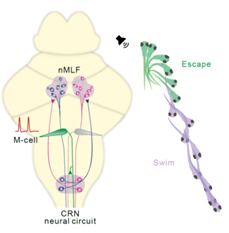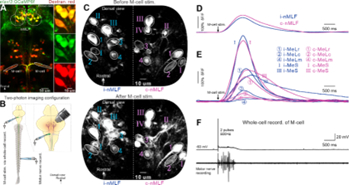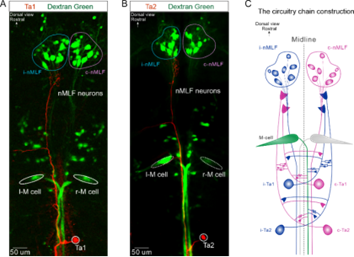
Figure 1. The structure of the chain like neural circuit produced by the defensive escape behavior of zebrafish
Facing the complex living environment, humans and animals usually need to adopt a series of coherent motor behavior combinations to complete specific goals and tasks. Taking the dunk in basketball as an example, athletes need three orderly and closely connected actions in time and space: running, taking off and dunking. At present, the research on motor control neural circuit mainly focuses on single motor behavior, but there is relatively little research on the neural mechanism of complex sequential behavior.

Figure 2. High frequency camera assisted identification of sequential motor behaviors "flee" and "run" in defensive escape response of juvenile zebrafish
The research group used juvenile zebrafish as the animal model of this study to deeply study the neural circuit generated by the control sequence motor behavior in the defensive escape response induced by harmful stimuli. Firstly, the researchers identified that the defensive escape behavior of zebrafish was an orderly combination of "flee" and "run" (forward swimming) in time by taking pictures with a high-frequency (500 frames per second) camera (Fig. 2). Animals use "flee" to change their body and movement direction (green module in Fig. 1), and use "run" to quickly stay away from risk factors (purple module in Fig. 1).

Figure 3. Whole cell recording and two-photon imaging experiments revealed that activation of unilateral Mauthner cells could excite the nucleus of medial longitudinal fascicle (nMLF) on both sides
The researchers used the whole cell patch clamp technique to activate a single Mauthner cell (motor command neuron that induced "flee" behavior), which can stably induced zebrafish to produce defensive escape sequence behavior, indicating that Mauthner cell activation was the key to induce defensive response (Fig. 3). Combining a series of methods such as multichannel whole cell patch clamp recording, two-photon imaging and laser elimination, the researchers found that Mauthner cells induce "running" (swimming) behavior by activating nMLF neurons on both sides of the midbrain (previous studies showed that activating nMLF on both sides of the midbrain of zebrafish could produce forward swimming behavior) neurons (Fig. 2). Further studies found that Mauthner cells excited neurons in nMLF on both sides of the midbrain by activating cranial relay neurons (CRNs) (Fig. 4). After further using laser to eliminate the bilateral CRNs of juvenile zebrafish ex vivo and alive, the same harmful stimulation only induced the zebrafish to "flee" behavior rather than "run" behavior.

Figure 4. Mauthner cells, cranial relay neurons (CRNs) and the nucleus of medial longitudinal fascicle (nMLF) are connected by specific synapses to form a chain like neural circuit structure for unidirectional transmission of neural signals
In conclusion, this study revealed that the nervous system of teleost fish forms a chain like neural circuit structure for unidirectional transmission of neural signals by connecting Mauthner cells, CRNs and nMLF with specific synapses (Fig. 4C). This chain like neural circuit structure gave animals an important instinctive behavior to use complex sequence movement in dangerous situations, to quickly change the direction of movement and quickly escape from the source of danger, and greatly improve the survival probability. This study would provide a basis for us to understand the motor behavior of vertebrate brain control sequences.

This study was published in the classic journal Current Biology with the title " A neuronal circuit that generates the temporal motor sequence for the defensive response in zebrafish larvae" on July 20, 2021 (11 a.m. ET). XU Lulu, a doctoral student of Tongji University, and GUAN Na, an associate professor of Tongji University, were the co-first authors of the paper, and Professor SONG Jianren of Tongji University was the corresponding author. This study was supported and guided by researcher DU Jiulin of Institute of Neuroscience, Chinese Academy of Sciences, researcher HUA Yunfeng of the Ninth People's Hospital Affiliated to Shanghai Jiaotong University School of Medicine and Institute of Precision Medicine. This study was supported by the National Key R&D Program of China, the National Natural Science Foundation of China, Major Special Projects of Shanghai Municipal Science and Technology Commission, Shanghai Fourth People's Hospital Affiliated to Tongji University, Clinical Center for Brain and Spinal Cord Research of Tongji University, and the Institute of Brain Function and Artificial Intelligence Transformation of Tongji University School of Medicine.
More information: https://www.sciencedirect.com/science/article/pii/S0960982221008836
